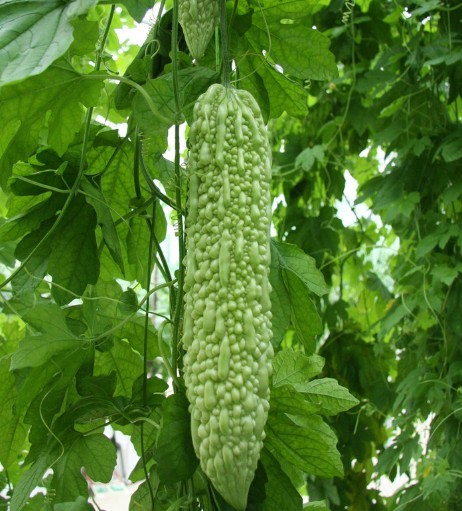Products
Contact us
- Changsha Herbal Ingredient Co.,Ltd
- Tel: 0086-731-88250818
- Add:No.56,Zhanxing Rd,Changsha,China,410205.
 sales@herbal-ingredient.com
sales@herbal-ingredient.com CHI-extracts
CHI-extracts

Bitter Melon Extract
Latin Name:Momordica charantia L
Active Ingredient:Charantin
CAS No:90063-94-8
Specification:1%-10% Charantin
MOQ:1kg
Lead Time:Within 7days after confirming order
Bitter Melon P.E Information:
Latin name: Momordica charantia
Common name: Bitter gourd, balsm pear(United States),kerala(India)
Family: Cucurbitaceae
Genus: Momordica
Part used: Fruit
Description:
The plant Momordica charantia belongs to the family cucuritaceae and is commonly known as bitter melon. Bitter melon grows in tropical and subtropic areas, including parts of East Africa, Asia, the Caribbean, and South America, where it is used as a food as well as a medicine. It produces beautiful flowers and prickly fruit .The fruit of this plant lives up to its name—it tastes bitter. Although the seeds, leaves, and vines of bitter melon have all been used, the fruit is the safest and most prevalent part of the plant used medicinally. The juice of the leaves and fruit or seeds is used as an anthelmintic. In Brazil, the dose for anthelmintic use is two or three seeds. The immature fruit of M.charantia tastes bitter due to the cucurbitacius. Cucurbitacius is comprised of a group of triterpenes including momordicosides, A-E, K, L, and momardicius I, II and III. The roots and fruit are used as an abortifacient.
History:
In traditional herbal medicine, bitter melon is thought to stimulate digestive function and improve appetite. This has yet to be tested in human studies.Being a relatively common food item, bitter melon was traditionally used for an array of conditions by people in tropical regions. Numerous infections, cancer, and diabetes are among the most common conditions it was purported to improve. Unripe fruit, seeds and aerial parts of Momordica charantia Linn. have been used in various parts of the world to treat diabetes. The leaves and fruit have both been used to make teas and beer or to season soups in the Western world. Nowadays Bitter Melon capsules and tinctures are widely available in the Western world where in herbal medicine they are being used for diabetes, HIV and other viruses, colds and flu and psoriasis.
Function:
1. Anti-diabetic Activity
Bittermelon contains steroidal saponins known as charantin, insulin-like peptides and alkaloids, which gives it hypoglycemic ability.Charantin stimulates the release of insulin and blocks the formation of glucose in the bloodstream, which may be helpful in the treatment of diabetes particularly in non-insulin dependent diabetes. The hypoglycemic effect is attributed to two factors:
(1)Charantin- a crystalline fraction obtained from an alcoholic extract of the fruit. Charantin administered at a 50mg/kg dose reduced hyperglycemia in rabbits by 42%. Charantin posesses pancreatic and extra-pancreatic action, and has a slight antispasmodic and anticholinergic effect.
(2)P-isulin (or v-insulin, for vegetable insulin). This is a large polypeptide structurally and pharmacologically comparable to bovine insulin. The p-insulin is composed of two polypeptide chains bound together by disulphide bonds. Subcutaneous and intramuscular administration of p-insulin produced hypoglysemic effects in diabetic patients, the peak effect was observed after 4-8 hours as compared to 2 hours for bovine insulin.
2. Anti-virus activity and etc.
Extracts standardized have proven efficacy in psoriasis, cancer infections, pain from neurological complications, and may delay the onset of cataracts or retinopathy and inhibit the AIDS virus through destroying viral DNA. The anti-cancer property is due in part to an enhancement of immune function. Study has shown that bitter melon extracts suppressed lymphocyte proliferation and macrophage and lymphocyte activity.
Support:
The antidiabetic effects of M.Charantica are clearly demonstrated using a streptozotocin (STZ)-induced diabetes mellites in the rabbit. The STZ induces an increase in blood sugar accompanied with an increase in blood urea, serum creatinine, serum cholesterol, free fatty acids, and a fall in glycogen reserve in the liver and loss of body weight. Ground bitter melon seed given with the rabbit food has a hypoglycemic effect on blood sugar levels which is accompanied by hypolipemic. The Beta-cells of the pancreas were activated by this treatment. Alloxan induces diabetes by destroying all B-cells of the pancreas. This indicates that the bitter melon hypoglycemic activity may work to some extent via these cells. This is partially supported through experiments conducted by Welihuida and co-workers. These researchers demonstrated that an aqueous extract of an unripe fruit of bitter melon is a potent stimulator of insulin release from B-cells of the pancreas.
In a clinic research carried out to evaluate the effect of Momordica charantia on the glucose tolerance of maturity onset diabetic patients, The standardized extract of Momordia charantia was found to significantly improve the glucose tolerance of 73% of the patients investigated while the other 27% failed to respond.
Dosage:
200 mg-250mg daily for relief of diabetics.
Safety:
High dosages can cause diarrhea. Those with hypoglycemia, diabetics on insulin should avoid bitter melon extract.
Chemistry:
Momordica charantia (bitter melon) is a proven hypoglycemic agent. One of the active principles responsible for this action is charantin, which is composed of a mixture of beta-sitosterol-beta-D-glucoside and 5,25 stigmadien-3-beta-ol glycoside. It is therefore important that the extract be standardized for both total bitter principles and charantin.




